Porsche
|
1930 - Present |
Country: |
 |
|
Ferdinand Develops The Mercedes-Benz K Model
Arguably the most sought after marque
for the classic car enthusiast, we should be grateful
for what Ferdinand and Ferry were able to develop. Dr.
Ferdinand Porsche rose to prominence in the early 1920's
as the then Mercedes Technical Director after designing
the first true Mercedes-Benz sports car, the 33/180
or "K" model.
This awesome car featured a 6.2-litre
six-cylinder engine with a single overhead cam valve
gear layout, and was of course equipped with a supercharger. After Daimler merged with Benz in 1926, Porsche could
not cope with the new company culture. Disappointed
at the conservative nature of his employer, Porsche
quit, and in 1930 he decided to go independent.
In 1931,
Ferdinand Porsche launched his consulting office in
Stuttgart, with his talented and hardworking son Ferry
among the employees. Shortly before the war came perhaps his greatest achievement,
the German "people's car", the Volkswagen "Beetle".
Ferdinand Porsche spent the years of World War II working
on military machinery, and was subsequently imprisoned
in France immediately after the war.
Ferry Develops The 356
It was during that period, however, that his son Ferry
set about producing a new sports car, initially in Austria,
which would carry his name. Not surprisingly, it utilized
many VW components. (For more detailed information on
Dr. Ferdinand Porsche, please see the article located
in the History section of this web site, and footnote
below).
Ferry's new car was given the type number "356",
and had a sheet metal chassis platform, with a fabricated
section at the rear to carry the engine and transmission
and the rear suspension. Initially the engine was a
1086cc version of the flat-four,
air-cooled, VW unit,
and it was mounted behind the line of the rear wheels.
With special
cylinder heads, it developed 40hp and gave
the car a top speed was 80mph.
The first coupe was completed in August 1948, and rather
spasmodic production began at Gmund, in Austria (Porsche
himself was Austrian by birth). However, from
1950 the
business was moved to Stuttgart, West Germany, where
his father had spent so many years of his life. The
first change he made was to construct the bodies from
steel rather than the aluminium as was used in the first
batch.
In April
1951 a 1.3-liter engine, producing 44hp at
4200rpm was fitted to the cars, and only six months
later a 1.5-litre version was also offered - and the
356 was offered in a choice of cabriolet or closed coupe
body styles. In the next few years this model evolved
gradually, with detailed but significant changes, rather
than by radical redesign. In mid 1952 the bumpers were separated from the body,
and a one piece windscreen replaced the original 2-piece
unit. Then a new transaxle with
synchromesh and a higher
torque capability was fitted, primarily to help the
356 cope with the 1500's 70bhp.
Development Of The Speedster
While this new unit
was designed by Porsche, it would be manufactured by
Getrag. But it was when Porsche's East Coast US distributor
indicated that it could sell a cheap Porsche sports
car that production became a serious concern, and a
new "Speedster" design was created. The Speedster had a very shallow windscreen and an almost
claustrophobic hood with small side screens - but on
the up side the car was extremely light and would prove
to make a very successful competition car - at a time
when on track success translated to showroom sales. In 1955 the car became the Type 351 and boasted an optional
1.6-litre engine, and then at the following Frankfurt
car show Porsche introduced their new "Carrera" model.
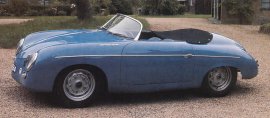
The Porsche 356 "Speedster" would
quickly become one of America's - and the worlds
- favourite sports cars...
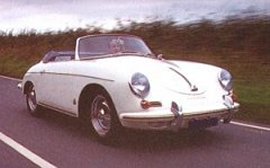
Ferry Porsche's new car, designated the 356,
would become an instant classic...
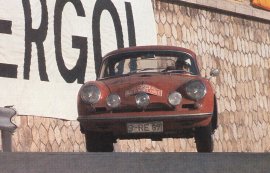 Naturally the 356 was perfect for racing, pictured
here in the 1964 Monte Carlo rally... Naturally the 356 was perfect for racing, pictured
here in the 1964 Monte Carlo rally...
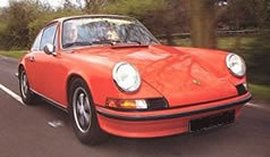
For most, the only three number designation
a Porsche should have includes the number 9
and 1. It would have included 0 (zero) had it
not been for Peugeot...
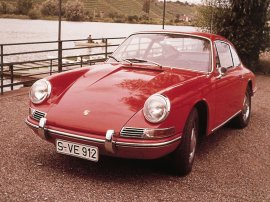
The cheaper Porsche 912, a 911 body fitted with
a 356 engine...(this image available in 1024x768
in our wallpaper section)
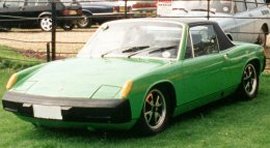
The mid-engined 914 was born from a joint venture
between Porsche and VW...
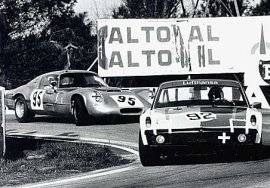
There would be 3,360 "Porsche Only"
914/6's, many finding their way onto the race
track, as seen here in the 1971 Le Mans...
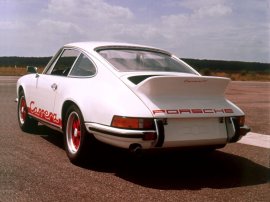
In 1972 the "Carrera" name would be
used again with the new 911 "F" series,
complete with "duck-tail" spoiler
and good for 0-100 in less than 6 seconds...

Supposedly more safer, certainly more traditional
and borrowing from the Audi parts bin, the 924
offered only "moderate" performance...
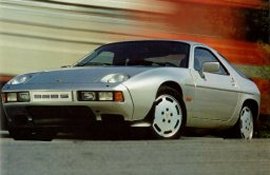
The 928 may have been a Porsche only affair,
but both the manual and auto transmissions came
courtesy of Mercedes-Benz...

The 944 was what many thought the 924 should
have been in the first place...
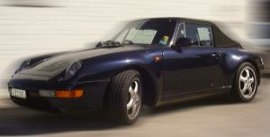
After 50 years the 911 retains much of the look
of Ferry's original 356...
|
The Famous Carrera Model
The Carrera was basically a standard 356 fitted with
a new four-overhead-cam engine, with cam drive by shafts
and bevel gears, twin sparking plugs and a roller bearing
crankshaft. Initially, in 1.5 litre form, it produced
110bhp at 7000rpm. Soon a 1.6 litre unit was available,
and then a 2.0 litre version, suitably dubbed the "Carrera
2" - a car good for an impressive 130mph.
But the ultimate Carrera came in the form of the GTL,
or Abarth-Carrera, that featured a beautiful all-alloy
body styled by Zagato. There were some 10,000 Porsches
built in 1956, and a year later the 1300cc engine was
droped, while new diaphragm clutches were adopted for
the first time. In 1957 the Speedster would be replaced
by the Speedster D, and would soon be renamed the "Convertible
D".
The 356B derivative had a slightly changed body style,
with a flatter nose but more pronounced headlamps, giving
a hint of the 911 model to come. In 1960 the "Super
90" version of this car went on sale, having a 90bhp
engine and a top speed well over 100mph. Features of
the Super 90 included revised rear suspension, radial
ply
tyres and fabulous "Koni" dampers which greatly
improved the Porsches roadholding.
The final manifestation of the type was the 356C, available
for 1963, in which disk
brakes were added, and where
derivatives were known as 1600C and 1600SC. Production
of all 356s ceased in 1965, after a grand total of 76,303
of all types had been made.
The Legend Of The Porsche 911
The legend that would create the three most famous numbers,
when put in sequence, began in 1964 with the release
of the Porsche 911. But did you know that Porsche originally
wanted to call their new sports car the 901? We can
thank Peugeot, who patented all three digit number configurations
containing a middle "0" (zero) for forcing Porsche to
change its name to 911.
Regardless of its model designation, the 911 remains
a triumph of development over design - and is still
as popular today as when it was originally released.
Despite many variations, pre-1974 vehicles are perceived
by many as the best classics of the marque to own. Like
the 356, the 911 had a pressed steel monocoque body/chassis
design, and a rear-mounted
air-cooled engine, but the
wheelbase was four inches longer than before, there
was genuine 2 + 2 seating, and the engine was a 1991cc
flat-six design producing 130bhp.
Styled By Butzi Porsche
Styling was by Butzi Porsche, the third generation of
this remarkable family, while engine development had
been led by Ferdinand Piech, another grandson of the
founder. Compared with the old car, there were many
chassis changes, for the front suspension was now an
intriguing mix of MacPherson strut linkage, but longitudinal
torsion bars as the springs, while rear suspension was
by semi-trailing arms, and transverse torsion bars.
There was rack and pinion steering, disk
brakes all
round, and a five-speed, all-synchromesh gearbox, mounted
ahead of the engine, and the line of the rear wheels.
Although early versions suffered from inadequate roadholding,
partly due to the fitment of narrow wheels and tires,
the type was gradually but successfully improved.
Indeed, the whole, long-running, story of the 911 family
is one of the diligent development of a basic theme.
The first major up-grading came in the summer of 1966,
when the 160bhp 911S was launched, now fitted with ventilated
disk brakes, five-spoke alloy road wheels, and giving
a top speed of at least 140mph. At the same time, the
first derivative from the original fastback coupe body
style was announced, this being the "Targa" open-top
car.
Unlike traditional convertibles, it had a permanent
roll-protection bar fixed in a loop, above and behind
the front seats. The term 'Targa' has now been adopted
all over the motoring world, to describe this sort of
configuration. While all eyes were naturally on the
911, Porsche realised it needed to create an entry level
sports car after production of the 356 ended.
The 912 would be less sophisticated (and thus cheaper
to manufacture) and provide Porsche with the perfect
replacement. The 912 was effectively a 911 body/chassis
and suspension set up, but fitted with the 1582cc four
from the obsolete 356. By 911 standards the performance
of the 912 could be best described as "modest", however
a total of 30,300 were sold until the car was superseded
in part by the 911T and the Type 914.
The Sportmatic Semi Automatic
In 1967, Porsche astonished the world by offering a
semi-auto "Sportmatic" transmission, in which there
was a torque converter and a clutch, but clutch control
was by a micro-switch in the
gear lever, which still
had to be used to change ratios.
In 1968 the new "B"
series cars had their wheelbase extended by two inches
by moving the rear wheels backward relative to the floor-pan
and engine/transmission position. The engine's crankcase
was to be made from magnesium, rather than aluminium,
and the 911S was given six inch wide wheel rims.
A year later the S and 911E engine had their multiple
carburettor setup replaced by Bosch fuel injection,
while to fill the gap at the lower price range left
by the demise of the four cylinder 912, the 110bhp 911T
with a normal carburettor setup joined the range.
The
C-Series cars, announced in summer 1969, had their engine
capacity enlarged to 2195cc, and two years later the
E-Series cars appeared, fitted with an even larger 2341cc
engine. In each case, this was done to increase low
speed torque, thus ensuring the cars "driveability"
around town. - and of course to help offset the power
decrease inflicted by the fitting of anti-pollution
equipment required to meet tough new US
exhaust emission
legislation.
The Controversial Porsche 914
1969 also saw the release of the somewhat controversial
914; yet another mould-breaking design, intended to
be a lower cost range that the 911, using many mass-production
parts.
Because the mid-engine layout had been so successful
in motor sports, it was natural that a similar design
be used for the 914. In this case, the engine was located
ahead of the rear wheels, with the transmission behind
it. Porsche were well aware that the folk at Volkswagen
were keen to boost their image, and so it was decided
to make the 914 a joint venture.
The new "VW-Porsche" would use a VW engine and transmission.
The structure was a conventional steel monocoque, with
distinctive (some thought strange) styling. Front suspension
was from the 911, but the semi-trailing rear suspension
was linked to coil springs.
At first, the car had a
1679cc
air-cooled flat four (from the VW411), but from
1972 this was enlarged to the full 1971cc size, with
fuel injection. A total of 115, 646 were made up to
1975, when it gave way to the 924. It is interesting
to note that there was a "Porsche Only" version of the
914 (naturally VW having no part in its title).
This
car used the 911Ts 1991cc engine and was dubbed the
"914/6", but unfortunately it was not a success. Only
3,360 were built, before being dropped from the model
line-up altogether in 1972.
The Revival Of The Carrera
In 1972 the F-Series heralded the revival of the "Carrera"
name, the new model fitted with a 2687cc engine good
for 210bhp at 6300rpm and a top speed of 150mph, even
wider (seven inch) rear wheel rims, flared wheel arches,
a duck-tail spoiler, and a great competition potential.
The 0 to 60 mph dash could be completed in an amazing
5.5 seconds (yes, you read right, 5.5 seconds in 1972!).
The new 2687cc engine was so well sorted that Porsche
decided that in 1973 they decided to fit it to all models
- but to differentiate the upmarket "Carrera" Porsche
fitted an even larger 2993cc engine good for 230bhp.
All cars now used Bosch fuel injection, and there were
important detail style changes involving much larger
front and rear bumpers. 1974 would see the release of
the mighty "911 Turbo", featuring a body style similar
to the race modified Carrera RSR, with even more outrageous
wheel-arch flares and rear spoiler.
The 2993cc engine
was mated to a KKK
turbocharger, in turn linked to a
Bosch K-Jetronic
fuel injection system, and providing
the car with 260bhp delivered to the road courtesy of
215-section Pirelli P7 tyres.
Quite simply, the Turbo set new super-car standards,
and from August 1977 it was made even more outstanding
by the fitment of an even larger 3299cc engine, good
for 300bhp at 5500rpm. The Pirelli
tyres were yet larger
225 section type, and gave the car a top speed over
160mph. In 1975 the 911S and 911SC 2.3 litre models
made way to the re-developed cars 3 litre powered cars,
good for 200bhp and dubbed the "Carrera 3".
Two years later there would be a further name change,
with the Carrera name being dropped, and the 911SC title
being revived. But it would take until 1982 for Porsche
to manufacture a full convertible model - aptly called
the "Cabriolet". As another stop-gap, Porsche re-released
the 912 model in 1976 for sale in the US only. Powered
by the 2 litre flat-four, it was to be a short-lived
marketing effort.
A Break With Design, The Porsche 924
But the really important car of 1975 was not the re-introduced
912, but the 924, which was a complete design break
for the marque. Undeniably designed to be a "cheaper"
Porsche, like its predecessor the 912 it used many VW
Group (or, to be more precise, Audi) parts. But the
biggest news came in the cars layout, for the first
time a Porsche designed along traditional lines with
a water-cooled engine fitted at the front of the car.
The new layout was much more logical for the safety
conscious mid-1970s, providing more predictable roadholding,
and better occupant protection in crashes. The engine
was linked to the transmission by a large diameter alloy
torque tube. The engine itself was a 2-litre, single
overhead camshaft conversion, of the previous 1.9 litre
Audi 100 four-cylinder unit, and would later be used
in the VW LT van, and in the American AMC Gremlin. Fitted
with Bosch K-Jetronic fuel injection, the engine was
good for 125bhp in Europe and Australia, but in the
emission controlled US it developed a mere 95bhp.
Though early models were criticized for being too noisy,
and too basic, the styling was always considered pleasant,
if conservative. Porsche struck a production deal with
VW/Audi, whereby assembly would take place at the ex-NSU
factory some little distance from Stuttgart.
The 924 Turbo was offered in 1979, and was a considerable
improvement over the basic model, now fitted with a
177bhp engine. Externally, it was distinguishable by
the extra cooling vents in the nose, and the wrap-around
spoiler on the tail. A limited-production model of the
same period was the 924 Carrera GT, which was a modified
Turbo, with flared wheel arches, more power (210bhp)
and aimed at the racing circuit.
Porsches Latest Interpretation Of The Modern Super Car
In 1981 Porsche released the new 944 model, which was
basically a further developed 924, fitted with a new
Porsche designed slant-four engine with a single overhead
camshaft and good for 163bhp from its 2479cc engine.
This, the enthusiasts said, was what the real 924 should
always have been, and with its enhanced performance
and smoothly shaped wider wheel arches it soon became
a sales success. In the meantime, the 928 had arrived
in 1977, as Porsches latest idea of the modern super-car.
Like the 924, it had a front-mounted, water-cooled,
engine, and rear gearbox, and broadly similar styling
outlines, but it was all-new, and totally Porsche. Designed
to attack the lucrative expensive coupe market sector,
it was smooth, silent, extremely efficient, but somehow
without much character as first revealed.
The rounded
styling, with its large expanse of glass and wide hips
was perhaps neither pretty nor aggressive, something
many believed a sports car should be. Its engine was
a new light-alloy V8 unit of 4474cc, with single overhead
camshafts per bank, and the inevitable Bosch K-Jetronic
fuel injection, good for 240bhp at 5250rpm. There was
a choice of either five-speed manual or three-speed
automatic transmissions, both courtesy of the good folk
at Mercedes-Benz.
The original 928 was actually slower than the 911, and
because it was heavier it also suffered the inevitable
fuel consumption woes. Sales were slow at first, and
so from 1979 it was joined by the 928S, where the engine
size was enlarged to 4664cc and resulting power increased
to 300bhp. New
aerodynamic aids were added, most notably
a wrap-around rear spoiler under the tailgate glass.
Importantly for the time, the revisions to the car meant
it could join the "Over 150mph" class, and was capable
of 0-60mph in 6.5 seconds. The 928S2 which followed
had 310bhp on tap, and naturally even greater performance.
The latest development, for the start of the 1984 model
year was the enlargement of the 'base' engine size,
once again enlarged, this time to 3164cc and good for
231bhp at 5900rpm - and just to confuse everybody the
"Carrera" name was resurrected for a third time.
Footnote: Although Ferdinand Porsche
is believed to have been politically naïve, consumed
with engineering, he was arrested after the war and
charged with collaboration. He was freed in 1947 after almost twenty months in prison.
His health was poor. In the meantime, the Porsche firm
did whatever it could to stay in business. It designed
its own sports car, the first car to carry the name
Porsche.
Type 356 was the project number. One year after Ferdinand
Porsche was released from prison, he witnessed the birth
of the Porsche sports car. The very first Porsche, a
hand-built aluminium prototype, was completed on June
8, 1948. Ferdinand Porsche died on January 30, 1952,
from the effects of a stroke he had suffered earlier.
He died after seeing his dream of a Porsche sports car
become a reality.
Recommended Reading: The House Of Porsche |
The House of Porsche - A Pictorial History |
Ferdinand Porsche |
Porsche Car Reviews



